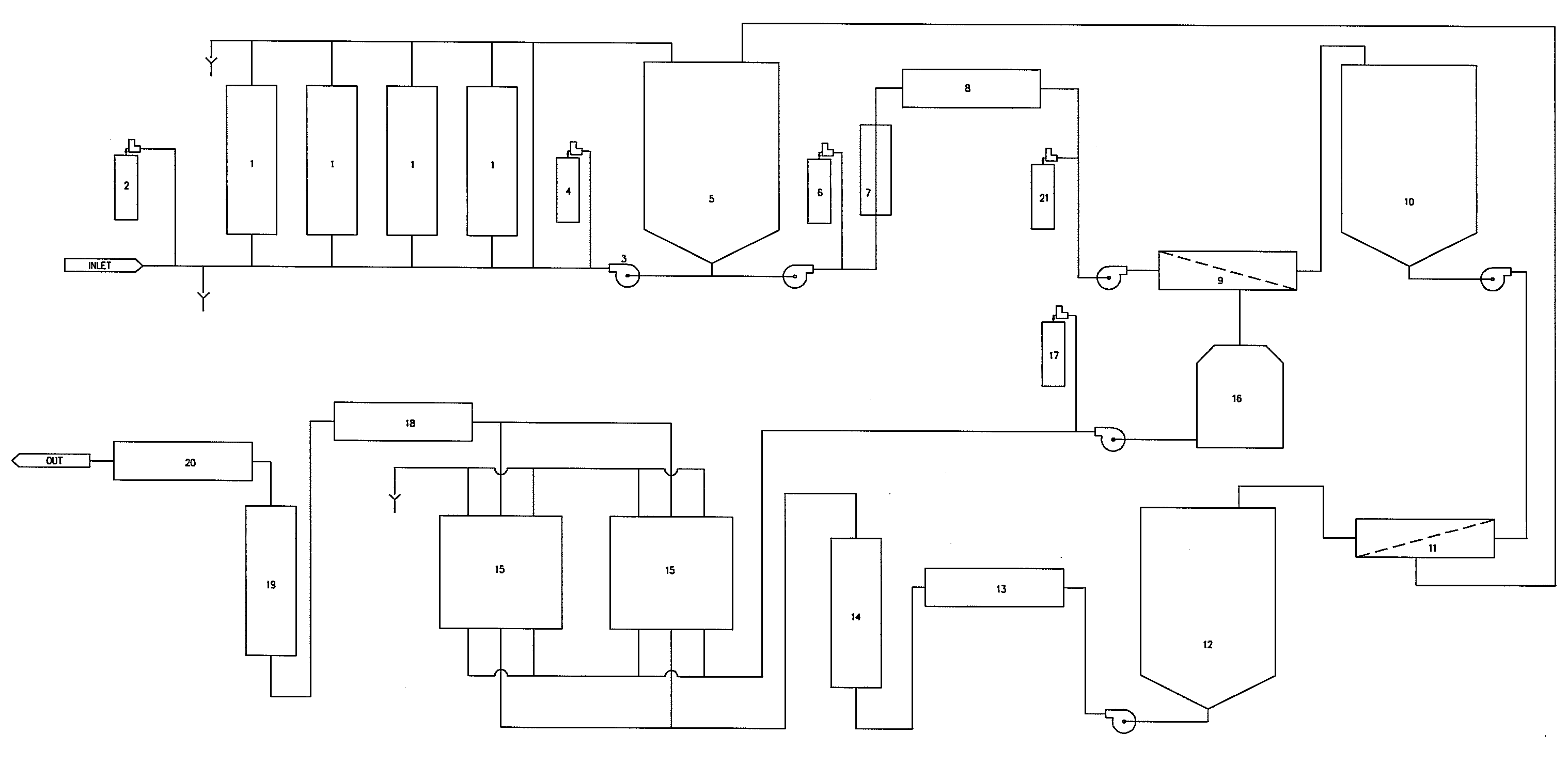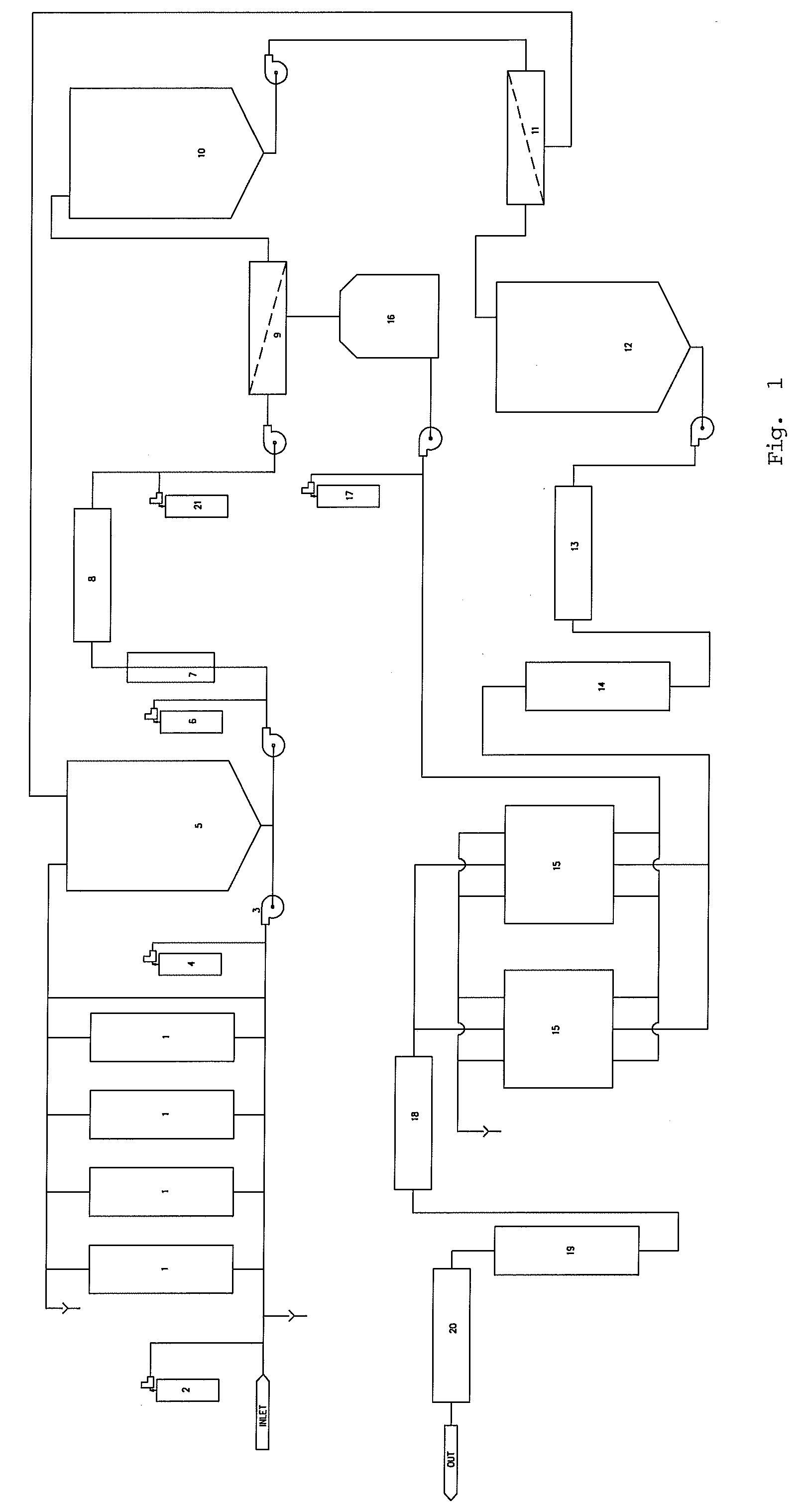[0007]The present invention eliminates the problems associated with known water purification systems by eliminating the use of media vessels during water purification. The lack of media vessels means that water purification can take place without pretreatment, and thus without the need to employ the steps of
multimedia filtration, carbon
filtration, and / or
water softening. There are only a handful of treatment systems and processes presently utilized for
water treatment in the water purification industry, all of which are known. Innovation in this industry therefore comes in the combination of these known systems and processes in new ways to achieve different or better results and for use in new or different applications. Accordingly, the present invention utilizes a unique combination of known technologies to produce high purity water and is relevant to any application that requires the production of high purity water, though embodiments of the present invention are particularly well suited to the requirements of the
pharmaceutical industry, and particularly to the production of
purified water that is suitable for injection. Embodiments of the present invention are thus capable of producing both of the two basic types of water regulated by the USP: (1)
purified water; and (2) purified water that is suitable for injection.
[0008]The present invention eliminates the use of a water softener and the use of any other standard
water treatment media in the treatment of water to produce purified water. The present inventors have discovered a system that produces the same, and often improved, results as a water softener, but without the presence of a
water softening device. In some embodiments, water is subjected to two passes of reverse
osmosis in order to remove minerals and therefore decrease the
hardness of the water before it enters an
electrodeionization system. In these embodiments, an acid is injected into an embodiments of the water purification system of the present invention upstream of a
high intensity ultraviolet (“UV”) light in order to acidify the water and prevent the scaling that can be caused by untreated water. Alternatively, a
magnetic field may be used upstream of the UV light in order to alter the scaling characteristics of the water. Once treated by the UV light, the water proceeds through the system to a
first pass of reverse
osmosis, where the prior acidification of the water, used to prevent scaling in the UV light, also helps to prevent scaling in the reverse
osmosis component. The reverse osmosis process removes minerals from the water, which may cause scaling within the reverse osmosis system. To prevent this, an antiscalant is added to the water after it has been treated with UV light and before it is passed through the first reverse osmosis treatment. The antiscalant is not added to the water in advance of UV
light treatment as
high intensity UV light has a tendency to break some of the bonds in the antiscalant chemical, rendering it less effective. The water resulting from the
first pass of reverse osmosis is then again acidified, to prevent scaling, and then proceeds to a second pass of reverse osmosis. The water resulting from the second pass of reverse osmosis is then passed through an
electrodeionization system. Water treated in this manner is equivalent to, and in many instances is an improvement to, water that has been treated by a water softener and / or by the use of any other standard water treatment media.
[0015]In some embodiments, the water purification system is equipped with a means of injecting acid into the water before the water enters either the first and / or the second high intensity UV light chamber to prevent scaling of the light transmitting surface of the UV
light source. In further embodiments, the water purification system is equipped with a means of applying an
electromagnetic field to the water before the water enters either the first and / or the second high intensity UV light chamber to prevent scaling of the light transmitting surface of the UV
light source. In still further embodiments, the water purification system is equipped with a means of injecting
sodium metabisulfite downstream of either the first and / or the second high intensity UV light chamber. In still further embodiments, the water purification system is equipped with a means of injecting an antiscalant downstream of either the first and / or the second high intensity UV light chamber. According to still further embodiments of the present invention, a third high intensity UV light is added prior to or following the second
ultrafiltration membrane barrier, the third high intensity UV light being of the same configuration as the first and / or second high intensity UV light.
 Login to View More
Login to View More 

